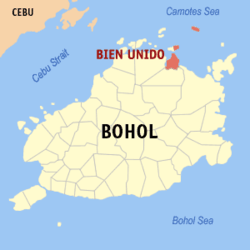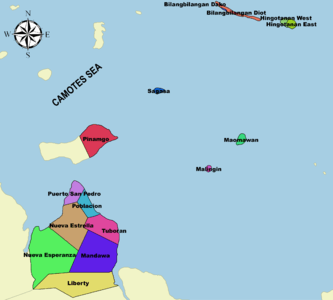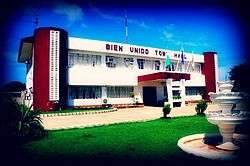Bien Unido, Bohol
| Bien Unido | ||
|---|---|---|
| Municipality | ||
|
Bien Unido Town Hall | ||
| ||
 Map of Bohol with Bien Unido highlighted | ||
.svg.png) Bien Unido Location within the Philippines | ||
| Coordinates: 10°08′N 124°23′E / 10.13°N 124.38°ECoordinates: 10°08′N 124°23′E / 10.13°N 124.38°E | ||
| Country | Philippines | |
| Region | Central Visayas (Region VII) | |
| Province | Bohol | |
| District | 2nd district of Bohol | |
| Founded | 1981 | |
| Barangay | 15 (see § Barangays) | |
| Government [1] | ||
| • Type | Sangguniang Bayan | |
| • Mayor | Gisela Boniel (NPC) | |
| • Vice mayor | Rene Borenaga | |
| • Town Council |
Members
| |
| • Representative | Erico Aristotle Aumentado | |
| Area[2] | ||
| • Total | 27.39 km2 (10.58 sq mi) | |
| Population (2015 census)[3] | ||
| • Total | 27,115 | |
| • Density | 990/km2 (2,600/sq mi) | |
| • Voter (2016)[4] | 15,858 | |
| Time zone | PST (UTC+8) | |
| ZIP code | 6326 | |
| IDD : area code | +63 (0)38 | |
| Income class | 4th class | |
| PSGC | 071248000 | |
| Website | Official website | |
Bien Unido is a 4th municipal income class municipality in the province of Bohol, Philippines.[2] According to the 2015 census, it has a population of 27,115.[3] In the 2016 election, it had 15,858 registered voters.[4]
The name "Bien Unido" is a Spanish word translated to "well united" in English and is the youngest municipality in Bohol being founded in 1981 after it was carved out and separated from the municipalities of Trinidad and Talibon.[5] Among the principal industries in Bien Unido are rice farming, seaweed farming, livestock farming, algaculture, fishing, and mat weaving. The town gained the nickname as the de facto Seaweeds Capital of the Visayas.[6]
Bien Unido is 108 kilometres (67 mi) (2 hours or more) from Tagbilaran by road. Cebu City is approximately over 4 hours via the Cebu—Talibon or Cebu—Tubigon RORO, while it takes approximately 3 hours via the Cebu—Getafe ferryboat. Bien Unido can also be reached directly from Cebu City through Barangay Pasil Fish Port via ferryboat in more than 3 hours.
The "Bien Unido Double Barrier Reef Marine Park" is the first underwater pilgrimage in Asia, established in 2012. It is situated along the Danajon Bank.[7]
Geography
Barangays
Bien Unido comprises 15 barangays. Of these, only Bilangbilangan Diot and Hingotanan East are classified as rural and the rest are urban.[2]
|
| |||||||||||||||||||||||||||||||||||||||||||||||||||||||||||||||||||||||||||||||||||||||||||||||||||||||||||||||||||||||||||
Demographics
| Population census of Bien Unido | |||||||||||||||||||||||||
|---|---|---|---|---|---|---|---|---|---|---|---|---|---|---|---|---|---|---|---|---|---|---|---|---|---|
|
| ||||||||||||||||||||||||
| Source: Philippine Statistics Office[3][8][9] | |||||||||||||||||||||||||
In the 2016 election, it had 15,858 registered voters, meaning that 58% of the population are aged 18 and over.[4]
The people in the municipality speak Cebuano and the Boholano dialect. Filipino and English are generally understood.
Education
-
- Bien Unido Academy
- Holy Child Academy of Bien Unido
- Hingotanan National High School
- Pres. Carlos P. Garcia Tech-Voc School of Fisheries and Arts
-
- Bien Unido Central Elementary School
- Bilangbilangan Daku Elementary School
- Hingotanan Elementary School
- Malingin Elementary School
- Mandawa Elementary School
- Maomawan Elementary School
- Montessori Educational Learning Center of Ubay, Bien Unido Branch[10]
- Nueva Esperanza Elementary School
- Nueva Estrella Elementary School
- Pinamgo Elementary School
- Sagasa Elementary School
Gallery
-

A sketch drawing of the political map of Bien Unido
References
- ↑ "Municipality". Quezon City, Philippines: Department of the Interior and Local Government. Retrieved 31 May 2013.
- 1 2 3 "Municipal: Bien Unido, Bohol". PSA. Philippines: National Statistical Coordination Board. Retrieved 8 January 2016.
- 1 2 3 4 "Region VII (CENTRAL VISAYAS)". Census of Population (2015): Total Population by Province, City, Municipality and Barangay (Report). PSA. Retrieved 20 June 2016.
- 1 2 3 "2016 National and Local Elections Statistics". Commission on Elections. 2016.
- ↑ History of Bien Unido – Bohol-Philippines.com.
- ↑ http://www.philstar.com/region/2015/12/22/1535307/bien-unido-town-celebrates-34th-year-mass-wedding
- ↑ Only in the Philippines: An Underwater Grotto in a Double-Barrier Reef! – ChoosePhilippines. January 2015
- 1 2 "Region VII (CENTRAL VISAYAS)". Census of Population and Housing (2010): Total Population by Province, City, Municipality and Barangay (Report). NSO. Retrieved 29 June 2016.
- ↑ "Region VII (CENTRAL VISAYAS)". Census of Population (1995, 2000 and 2007): Total Population by Province, City and Municipality (Report). NSO. Archived from the original on 24 June 2011.
- 1 2 "List and Status Of Private Schools" (PDF). DepEd – Region VII. 22 January 2015. Retrieved 5 March 2015.
- ↑ "Catholic Educational Institutions". Roman Catholic Diocese of Talibon. 1 January 2014. Retrieved 5 March 2015.
- ↑ "List of Elementary Schools". DepEd – Bohol. 1 January 2015. Retrieved 5 March 2015.
External links
 |
Camotes Sea |  | ||
| Talibon | |
Camotes Sea | ||
| ||||
| | ||||
| Trinidad | Ubay |


